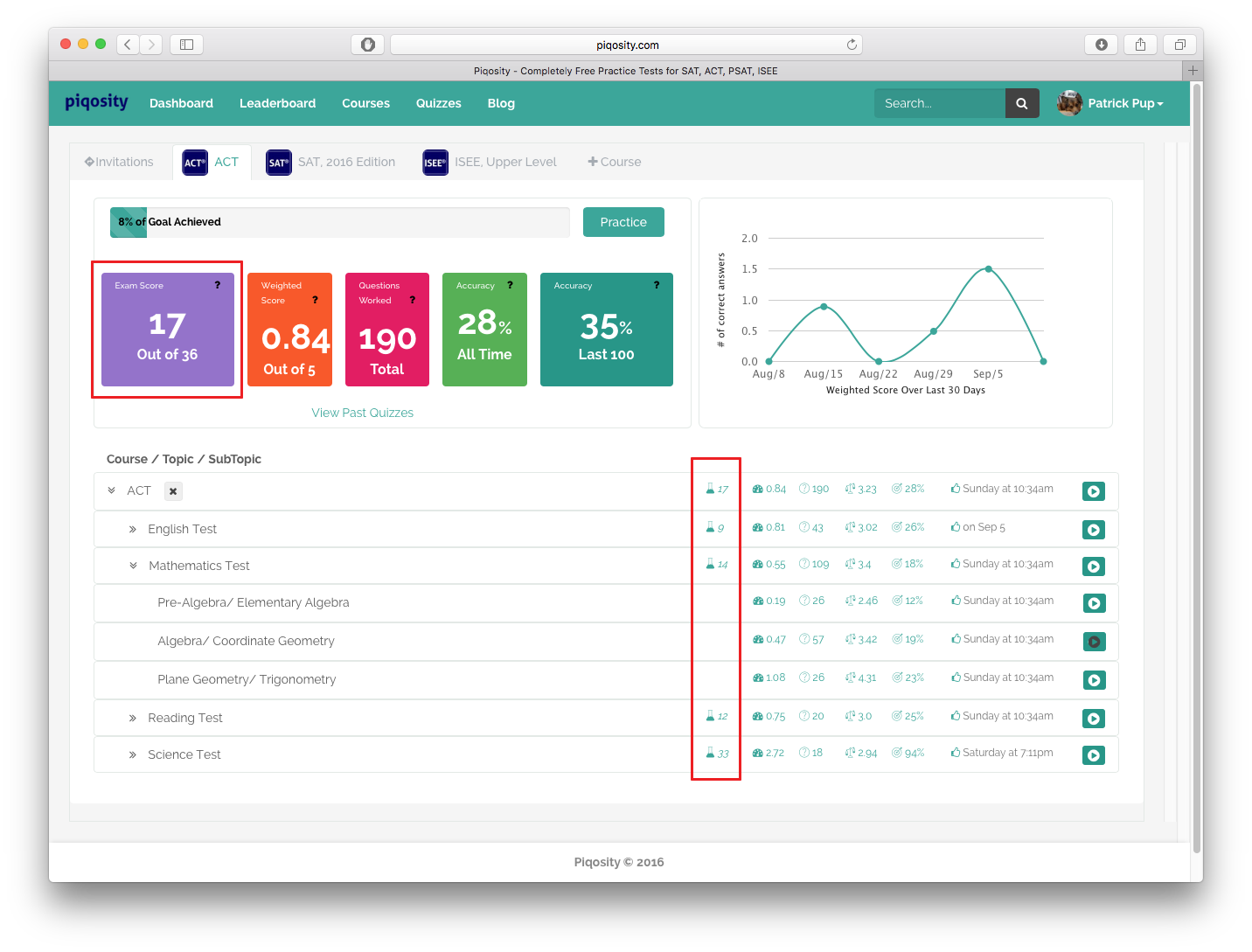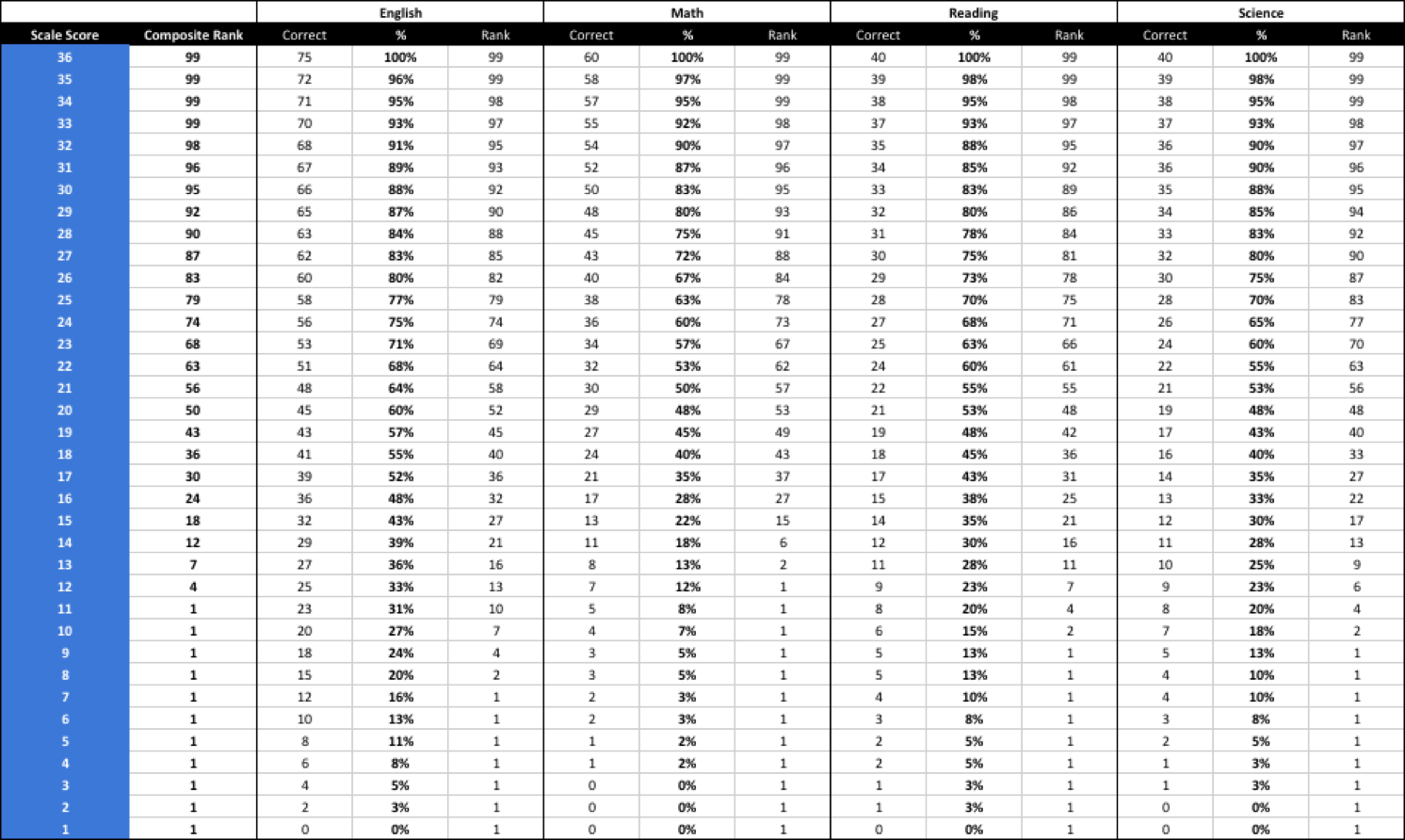For students preparing for the ACT college admissions test, Piqosity now displays real time estimates of their actual test score on the 0 to 36 scale used by the ACT. Students can find these estimates in three places:
- On the dashboard as an overall score in the purple box
- On the dashboard as a topic score (beside the icon)
- English Test
- Mathematics Test
- Reading Test
- Science Test
- On the quiz results screen after finishing a problem set

How Piqosity Estimates Your ACT Score
To estimate your score using the ACT’s 0-36 scale score methodology, we simply extrapolate from the percentage of questions you got correct. The table below shows a scoring chart provided by ACT; however, we’ve inserted in a new column “%” to show how many questions you needed to get right to be in a certain “rank.”
For example, let’s say that you’re taking a 10-question ACT practice quiz on Piqosity in math and you get 8 questions correct, or 80%. Using the chart below, Piqosity would estimate your ACT score to be a 29. We made this estimate because:
- You got 8 out of 10 questions correct or 80%
- Using the chart below for Math, we say that 80% corresponds with a rank of 93
- Looking on the far left of this chart, the composite rank of 93 is a scale score of 29

Furthermore, Piqosity makes ACT real score estimates at three levels:
- Quiz
- Topic
- Overall
At the quiz level, the score estimate is simply made from the percentage of questions you got right on that individual set of questions.
At the topic level, the score estimate is based off of the last 100 questions you worked in that specific topic (english, math, reading, science).
At the overall level, the score is the average of your 4 topic-level scores. Therefore, the overall estimate is always updating based off of your last 100 questions in each topic.
Estimates Are Only Estimates
While Piqosity wants to give you a very good idea of how you’re going to do on the test day, these estimates are far from perfect. Simply deriving a scale score (0-36) based off of the percentage correct is far too simplistic for predictive purposes because there are several other variables that are unaccounted for:
- Time
- Question Difficulty
- Other Test Takers (norm group)
When you sit down to take the actual ACT under timed conditions, you’re under pressure to work quickly. As such, you’re likely to make more mistakes than you might otherwise on Piqosity. We are working to add a timer in a future product release.
The ACT test makers assemble a full-length test very carefully such that each iteration of the test is the same difficulty overall. However, because Piqosity mixes and matches content according to individual student needs, it’s practically impossible for us to ensure that each practice set a student takes will be the same average difficulty as an actual ACT.
What this means is that if you get 100% of easy questions right, you’re probably not going to get a perfect score, 36, as Piqosity might tell you. Try to ensure that your average question difficulty is as close to 3.2 as possible (out of 5) to ensure more precise estimates. Piqosity shows the average question difficulty on the dashboard next to the icon.
Finally, your real ACT scaled score is based off of your relative rank to other students taking the ACT for the last three years. For example, if your composite score was a 21, that means you scored better than 56% of other students who took the exam over the last three years. However, there’s no way for Piqosity to currently know how this “norm group” will change, which is another reason why our estimate might not be accurate.
Unless you register for and take an actual ACT, no one will be able to tell you verifiably what your score will be. Fortunately, you can take the ACT as many times as you want and only send the scores to colleges that are the best.


